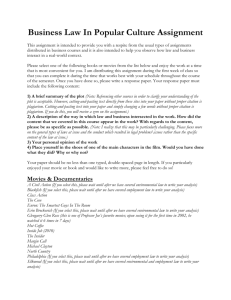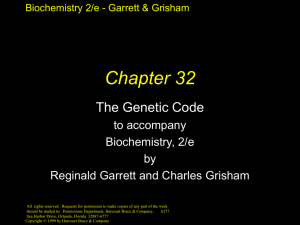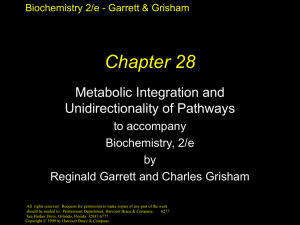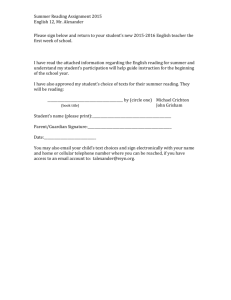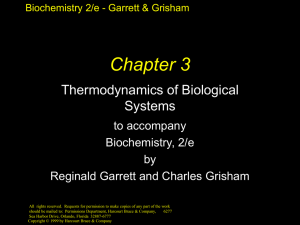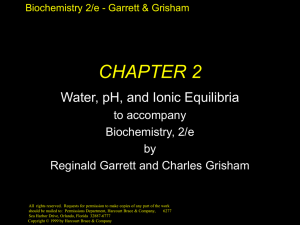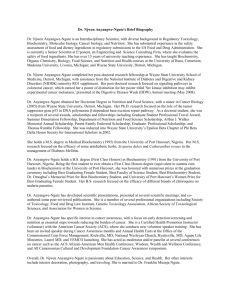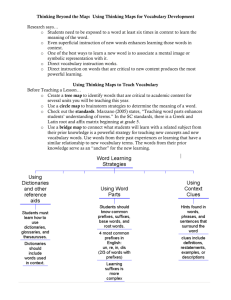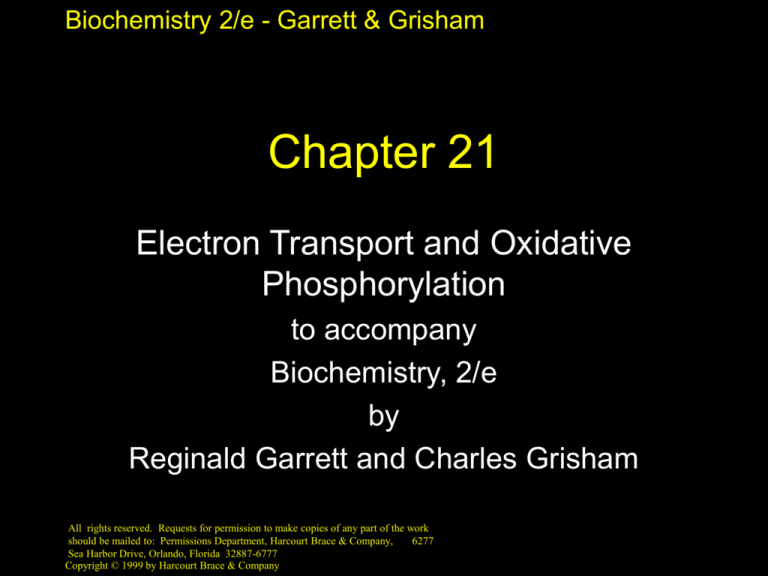
Biochemistry 2/e - Garrett & Grisham
Chapter 21
Electron Transport and Oxidative
Phosphorylation
to accompany
Biochemistry, 2/e
by
Reginald Garrett and Charles Grisham
All rights reserved. Requests for permission to make copies of any part of the work
should be mailed to: Permissions Department, Harcourt Brace & Company,
6277
Sea Harbor Drive, Orlando, Florida 32887-6777
Copyright © 1999 by Harcourt Brace & Company
Biochemistry 2/e - Garrett & Grisham
Outline
• 21.1 Electron Transport and Oxidative
Phosphorylation at Mitochondrial Membrane
• 21.2 Reduction Potentials - Understand Them
• 21.3 - 21.7 Details of Electron Transport
• 21.8, 21.9 Coupling and the ATP Synthase
• 21.10 Inhibitors of Oxidative Phosphorylation
• 21.11 Uncouplers Disrupt the Coupling
• 21.12-21.14 Final Details
Copyright © 1999 by Harcourt Brace & Company
Biochemistry 2/e - Garrett & Grisham
An Overview
• Electron Transport: Electrons carried by
reduced coenzymes are passed through a
chain of proteins and coenzymes to drive the
generation of a proton gradient across the
inner mitochondrial membrane
• Oxidative Phosphorylation: The proton
gradient runs downhill to drive the synthesis
of ATP
• It all happens in or at the inner mitochondrial
membrane
Copyright © 1999 by Harcourt Brace & Company
Biochemistry 2/e - Garrett & Grisham
Copyright © 1999 by Harcourt Brace & Company
Biochemistry 2/e - Garrett & Grisham
Copyright © 1999 by Harcourt Brace & Company
Biochemistry 2/e - Garrett & Grisham
21.2 Reduction Potentials
High Eo' indicates a strong tendency to be reduced
• Crucial equation: Go' = -nF Eo'
Eo' = Eo'(acceptor) - Eo'(donor)
• Electrons are donated by the half reaction with
the more negative reduction potential and are
accepted by the reaction with the more positive
reduction potential: Eo’ positive, Go' negative
• If a given reaction is written so the reverse is true,
then the Eo' will be a negative number and Go'
will be positive
Copyright © 1999 by Harcourt Brace & Company
Biochemistry 2/e - Garrett & Grisham
Copyright © 1999 by Harcourt Brace & Company
Biochemistry 2/e - Garrett & Grisham
21.3 Electron Transport
Figures 21.3 and 21.4 hold the secrets
• Four protein complexes in the inner
mitochondrial membrane
• A lipid soluble coenzyme (UQ, CoQ)
and a water soluble protein (cyt c)
shuttle between protein complexes
• Electrons generally fall in energy
through the chain - from complexes I
and II to complex IV
Copyright © 1999 by Harcourt Brace & Company
Biochemistry 2/e - Garrett & Grisham
Copyright © 1999 by Harcourt Brace & Company
Biochemistry 2/e - Garrett & Grisham
Copyright © 1999 by Harcourt Brace & Company
Biochemistry 2/e - Garrett & Grisham
Copyright © 1999 by Harcourt Brace & Company
Biochemistry 2/e - Garrett & Grisham
21.4 Complex I
NADH-CoQ Reductase
• Electron transfer from NADH to CoQ
• More than 30 protein subunits - mass of
850 kD
• Path:
– NADH FMN Fe-S UQ FeS UQ
• Four H+ transported out per 2 eCopyright © 1999 by Harcourt Brace & Company
Biochemistry 2/e - Garrett & Grisham
Copyright © 1999 by Harcourt Brace & Company
Biochemistry 2/e - Garrett & Grisham
21.5 Complex II
•
•
•
•
Succinate-CoQ Reductase
aka succinate dehydrogenase (from TCA cycle!)
aka flavoprotein 2 (FP2) - FAD covalently bound
four subunits, including 2 Fe-S proteins
Three types of Fe-S cluster:
– 4Fe-4S, 3Fe-4S, 2Fe-2S
• Path: succinate FADH2 2Fe2+ UQH2
• Net reaction:
– succinate + UQ fumarate + UQH2
Copyright © 1999 by Harcourt Brace & Company
Biochemistry 2/e - Garrett & Grisham
Copyright © 1999 by Harcourt Brace & Company
Biochemistry 2/e - Garrett & Grisham
Copyright © 1999 by Harcourt Brace & Company
Biochemistry 2/e - Garrett & Grisham
21.6 Complex III
•
•
•
•
•
•
CoQ-Cytochrome c Reductase
CoQ passes electrons to cyt c (and pumps H+) in
a unique redox cycle known as the Q cycle
The principal transmembrane protein in complex
III is the b cytochrome - with hemes bL and bH
Cytochromes, like Fe in Fe-S clusters, are oneelectron transfer agents
Study Figure 21.12 - the Q cycle
UQH2 is a lipid-soluble electron carrier
cyt c is a water-soluble electron carrier
Copyright © 1999 by Harcourt Brace & Company
Biochemistry 2/e - Garrett & Grisham
Copyright © 1999 by Harcourt Brace & Company
Biochemistry 2/e - Garrett & Grisham
Copyright © 1999 by Harcourt Brace & Company
Biochemistry 2/e - Garrett & Grisham
Copyright © 1999 by Harcourt Brace & Company
Biochemistry 2/e - Garrett & Grisham
Copyright © 1999 by Harcourt Brace & Company
Biochemistry 2/e - Garrett & Grisham
Copyright © 1999 by Harcourt Brace & Company
Biochemistry 2/e - Garrett & Grisham
21.7 Complex IV
•
•
•
•
Cytochrome c Oxidase
Electrons from cyt c are used in a fourelectron reduction of O2 to produce 2H2O
Oxygen is thus the terminal acceptor of
electrons in the electron transport pathway the end!
Cytochrome c oxidase utilizes 2 hemes (a
and a3) and 2 copper sites
Structure is now known - mostly!
• Complex IV also transports H+
Copyright © 1999 by Harcourt Brace & Company
Biochemistry 2/e - Garrett & Grisham
Copyright © 1999 by Harcourt Brace & Company
Biochemistry 2/e - Garrett & Grisham
Copyright © 1999 by Harcourt Brace & Company
Biochemistry 2/e - Garrett & Grisham
Copyright © 1999 by Harcourt Brace & Company
Biochemistry 2/e - Garrett & Grisham
Copyright © 1999 by Harcourt Brace & Company
Biochemistry 2/e - Garrett & Grisham
Copyright © 1999 by Harcourt Brace & Company
Biochemistry 2/e - Garrett & Grisham
Copyright © 1999 by Harcourt Brace & Company
Biochemistry 2/e - Garrett & Grisham
Coupling e- Transport and
Oxidative Phosphorylation
•
•
•
•
This coupling was a mystery for many years
Many biochemists squandered careers searching
for the elusive "high energy intermediate"
Peter Mitchell proposed a novel idea - a proton
gradient across the inner membrane could be
used to drive ATP synthesis
Mitchell was ridiculed, but the chemiosmotic
hypothesis eventually won him a Nobel prize
Be able to calculate theG for a proton gradient
(Equation 21.28)
Copyright © 1999 by Harcourt Brace & Company
Biochemistry 2/e - Garrett & Grisham
Copyright © 1999 by Harcourt Brace & Company
Biochemistry 2/e - Garrett & Grisham
21.9 ATP Synthase
•
•
•
•
Proton diffusion through the protein drives
ATP synthesis!
Two parts: F1 and F0 (latter was originally
"F-o" for its inhibition by oligomycin)
See Figure 21.25 and Table 21.3 for details
Racker & Stoeckenius confirmed Mitchell’s
hypothesis using vesicles containing the
ATP synthase and bacteriorhodopsin
Paul Boyer’s binding change mechanism
won a share of the 1997 Nobel in Chemistry
Copyright © 1999 by Harcourt Brace & Company
Biochemistry 2/e - Garrett & Grisham
Copyright © 1999 by Harcourt Brace & Company
Biochemistry 2/e - Garrett & Grisham
Copyright © 1999 by Harcourt Brace & Company
Biochemistry 2/e - Garrett & Grisham
Copyright © 1999 by Harcourt Brace & Company
Biochemistry 2/e - Garrett & Grisham
Copyright © 1999 by Harcourt Brace & Company
Biochemistry 2/e - Garrett & Grisham
Copyright © 1999 by Harcourt Brace & Company
Biochemistry 2/e - Garrett & Grisham
21.10 Inhibitors of Oxidative
Phosphorylation
• Rotenone inhibits Complex I - and helps
natives of the Amazon rain forest catch
fish!
• Cyanide, azide and CO inhibit Complex
IV, binding tightly to the ferric form
(Fe3+) of a3
• Oligomycin and DCCD are ATP
synthase inhibitors
Copyright © 1999 by Harcourt Brace & Company
Biochemistry 2/e - Garrett & Grisham
Copyright © 1999 by Harcourt Brace & Company
Biochemistry 2/e - Garrett & Grisham
Copyright © 1999 by Harcourt Brace & Company
Biochemistry 2/e - Garrett & Grisham
21.11 Uncouplers
Uncoupling e- transport and oxidative
phosphorylation
• Uncouplers disrupt the tight coupling between
electron transport and oxidative
phosphorylation by dissipating the proton
gradient
• Uncouplers are hydrophobic molecules with a
dissociable proton
• They shuttle back and forth across the
membrane, carrying protons to dissipate the
gradient
Copyright © 1999 by Harcourt Brace & Company
Biochemistry 2/e - Garrett & Grisham
Copyright © 1999 by Harcourt Brace & Company
Biochemistry 2/e - Garrett & Grisham
21.12 ATP-ADP Translocase
•
•
•
•
•
ATP must be transported out of the mitochondria
ATP out, ADP in - through a "translocase"
ATP movement out is favored because the cytosol
is "+" relative to the "-" matrix
But ATP out and ADP in is net movement of a
negative charge out - equivalent to a H+ going in
So every ATP transported out costs one H+
One ATP synthesis costs about 3 H+
• Thus, making and exporting 1 ATP = 4H+
Copyright © 1999 by Harcourt Brace & Company
Biochemistry 2/e - Garrett & Grisham
Copyright © 1999 by Harcourt Brace & Company
Biochemistry 2/e - Garrett & Grisham
21.13 What is the P/O Ratio??
•
•
•
•
•
i.e., How many ATP made per electron pair
through the chain?
e- transport chain yields 10 H+ pumped out
per electron pair from NADH to oxygen
4 H+ flow back into matrix per ATP to cytosol
10/4 = 2.5 for electrons entering as NADH
For electrons entering as succinate (FADH2),
about 6 H+ pumped per electron pair to
oxygen
6/4 = 1.5 for electrons entering as succinate
Copyright © 1999 by Harcourt Brace & Company
Biochemistry 2/e - Garrett & Grisham
21.14 Shuttle Systems for e -
•
•
•
•
Most NADH used in electron transport is
cytosolic and NADH doesn't cross the inner
mitochondrial membrane
What to do??
"Shuttle systems" effect electron movement
without actually carrying NADH
Glycerophosphate shuttle stores electrons in
glycerol-3-P, which transfers electrons to FAD
Malate-aspartate shuttle uses malate to carry
electrons across the membrane
Copyright © 1999 by Harcourt Brace & Company
Biochemistry 2/e - Garrett & Grisham
Copyright © 1999 by Harcourt Brace & Company
Biochemistry 2/e - Garrett & Grisham
Copyright © 1999 by Harcourt Brace & Company
Biochemistry 2/e - Garrett & Grisham
Net Yield of ATP from Glucose
•
•
•
•
It depends on which shuttle is used!
See Table 21.4!
30 ATP per glucose if glycerol-3-P shuttle
used
32 ATP per glucose if malate-asp shuttle
used
In bacteria - no mitochondria - no extra H+
used to export ATP to cytosol, so:
– 10/3 = ~3ATP/NADH
– 6/3 = ~ 2ATP/FADH2
Copyright © 1999 by Harcourt Brace & Company
Biochemistry 2/e - Garrett & Grisham
Copyright © 1999 by Harcourt Brace & Company

